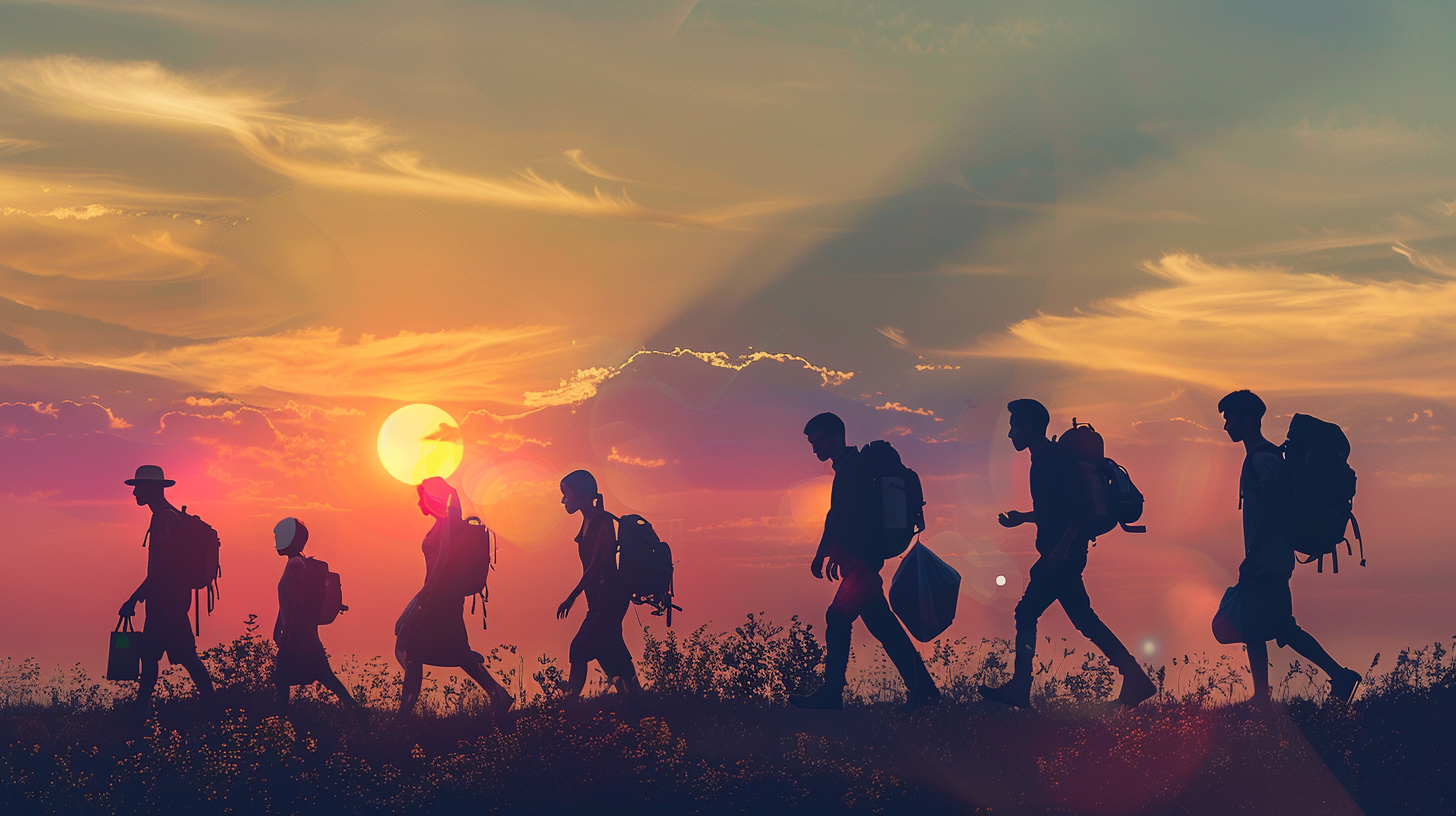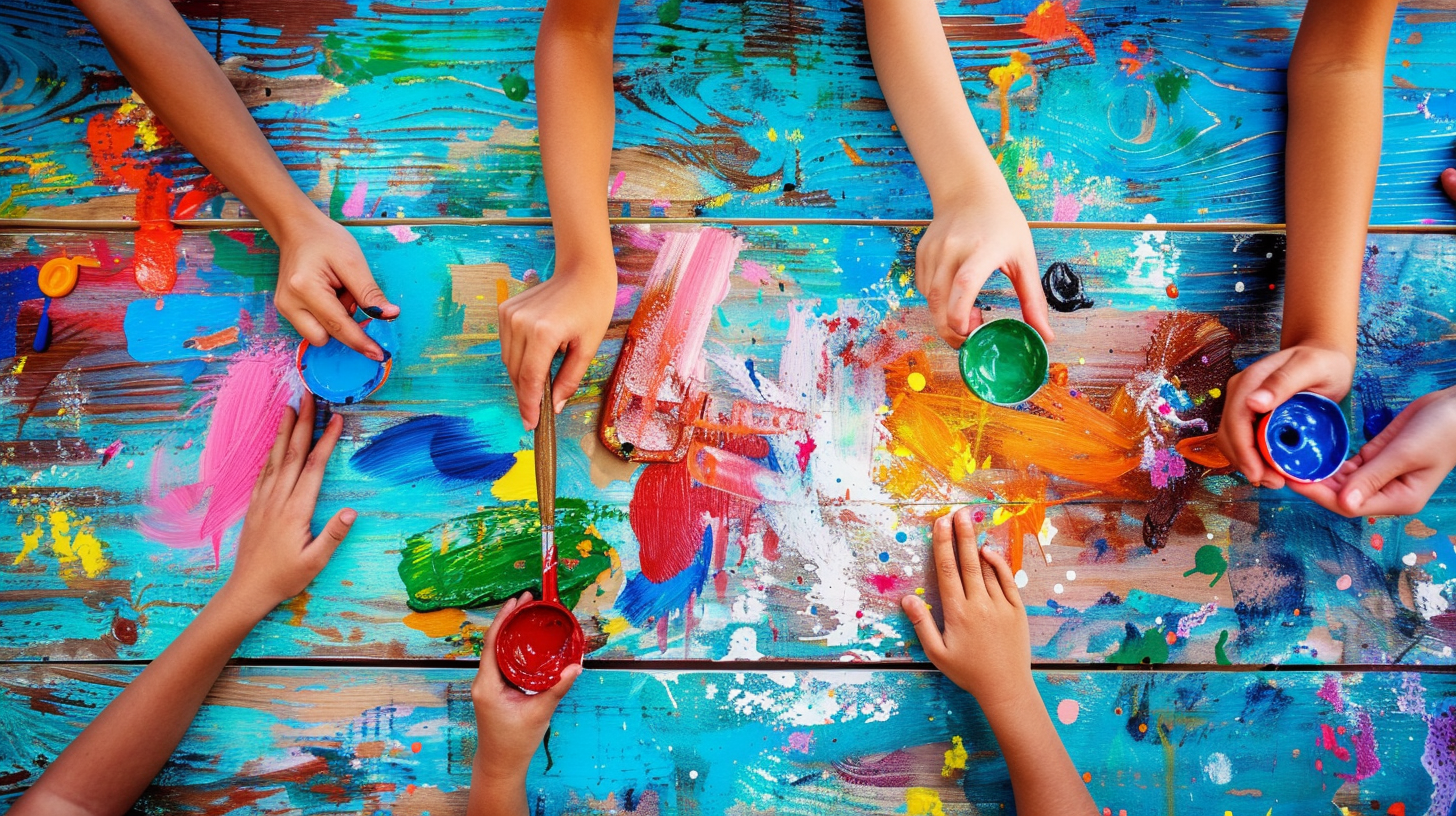Table of Contents Show
As rivers carve pathways through the landscape, so too has migration shaped the contours of our cultural evolution. We’ve witnessed firsthand how the movement of people across borders, continents, and oceans has not only redrawn the map of human geography but has also woven a rich tapestry of cultural interchange. From the spices in our kitchens to the stories that lull our children to sleep, the fingerprints of migration are everywhere. Yet, as we stand at the crossroads of history and future, one can’t help but wonder: what new patterns will emerge from the ongoing confluence of cultures? This question invites us to explore further, seeking insights into how our interconnected world continues to evolve.
Key Takeaways
- Migration reshapes cultural landscapes through the blending of traditions, languages, and arts.
- Cultural exchange mechanisms like trade and media facilitate the global spread of ideas and innovations.
- Artistic and culinary innovations thrive on the fusion of diverse cultural influences, enriching societies.
- Technological advancements and policy evolution will continue to shape the future of cultural interaction and preservation.
The Essence of Migration
Migration fundamentally shapes societies, blending and reshaping cultures as people move and settle in new areas. It’s a proof of our endless quest for freedom, opportunity, and a better life. We’re driven by the desire to explore, to escape adversity, and to dream of a brighter future. This relentless pursuit of happiness and security propels us across borders, pushing us to adapt and integrate into new communities.
As we settle, we don’t just bring our belongings; we carry our traditions, beliefs, and stories. These elements of our identity intertwine with the local culture, creating a rich tapestry of diversity that wouldn’t exist otherwise. It’s in this fusion of ideas and practices where innovation thrives. We see it in the blending of cuisines, the fusion of musical styles, and the melding of artistic expressions. These new creations enrich everyone, offering fresh perspectives and challenging old views.
We’re living in an era where migration is more important than ever. It challenges us to be open, to learn, and to grow together. It’s not just about moving from one place to another; it’s about the journey towards understanding, acceptance, and coexistence. We’re all seeking the same things: freedom, respect, and the chance to live our lives to their fullest potential.
Historical Perspectives
Reflecting on our shared history, it’s clear that migrations have always played a pivotal role in shaping the cultures and societies we comprehend today. This movement of peoples, whether by choice or necessity, has not only redrawn maps but also woven a rich tapestry of cultural diversity that we cherish. As we explore this historical perspective, we aim to highlight the undeniable influence of migration on cultural evolution, celebrating the freedom it embodies and the diversity it brings to our global community.
To capture the essence of this influence, consider these key historical migrations:
- The Great Migration (1916-1970), which saw six million African Americans relocate from the rural South to urban areas in the North and West of the United States, reshaping the cultural landscape of America.
- The mass movement of people during the fall of the Roman Empire, which introduced new cultural elements and practices into the Roman territories, altering the European cultural and genetic makeup.
- The Viking expansion (8th to 11th century), spreading Norse culture across Europe and beyond, influencing the cultures of modern-day UK, Ireland, and even parts of Russia.
- The Silk Road trade routes, facilitating not just the exchange of goods but also the flow of cultural, religious, and technological ideas between East and West.
- The migration of the Bantu-speaking peoples across Africa (around 1000 BC to AD 1000), spreading their language and culture across the continent and shaping its demographic and cultural landscape.
These migrations underscore the dynamic nature of cultural evolution, driven by the human quest for freedom, survival, and prosperity. Through these movements, cultures have blended, adapted, and evolved, highlighting the fluidity and resilience of human societies in the face of change.
Cultural Interchange Mechanisms
To understand how cultures evolve and blend, it’s pivotal to examine the mechanisms behind cultural interchange. We see these mechanisms at work when people move across borders, carrying with them their beliefs, practices, and traditions. This movement isn’t just about relocation; it’s a vibrant process of give-and-take that enriches societies.
Trade is one of the most powerful engines driving cultural exchange. When we trade goods, we’re also swapping ideas, styles, and innovations. It’s through trade that spices found their way into new cuisines, artistic styles spread across continents, and technological advancements leapfrogged across societies, sparking creativity and adaptation.
Migration, whether forced or voluntary, plays a significant role. Migrants bring their cultural heritage with them, weaving it into the fabric of their new homes. This blend creates a tapestry of cultural practices that might include food, music, and festivals, enriching the local culture while also preserving elements of their origins.
Media and technology have emerged as modern catalysts for cultural interchange. Through films, music, and social media, we’re exposed to and often adopt aspects of other cultures. This digital exchange speeds up the process of cultural blending, making it more immediate and widespread.
In all these mechanisms, there’s a common thread of freedom and the desire for expression. Cultures don’t stand still; they’re constantly evolving as people seek to express themselves and connect with others. It’s through this desire for freedom and connection that cultures blend and evolve, creating a world that’s richer and more diverse.
Language Evolution
Just as cultures blend and evolve, so too does language, adapting and transforming with every interaction. This dynamism is a tribute to our collective desire for expression and understanding, unfettered by geographical or historical constraints. As we move and mingle, our languages do too, creating rich, vibrant tapestries of communication that reflect our shared humanity and individual stories.
We’ve observed several key ways in which migration influences language evolution:
- New Vocabulary: We adopt words from other languages, expanding our lexicon to include concepts and items unique to different cultures.
- Language Mixing: Creoles and pidgins emerge as people combine elements of multiple languages, crafting new means of communication that bridge cultural divides.
- Accent and Pronunciation Changes: Exposure to different speech patterns influences how we pronounce words, subtly shifting accents over time.
- Grammar Simplification: In environments where speakers of different languages interact extensively, complex grammatical structures tend to simplify to facilitate understanding.
- Digital Language Evolution: Online communication platforms accelerate the spread of linguistic innovations, slang, and memes, further diversifying language.
These changes aren’t just academic; they’re deeply personal. They represent our collective quest for connection, our resilience in the face of change, and our unabashed curiosity about the world and its myriad cultures. Language evolution, driven by migration, underscores our inherent desire for freedom – to explore, to adapt, and to express ourselves in ways that transcend borders. It’s a powerful reminder that, at our core, we’re all storytellers, ready to share our tales and listen to those of others, in whatever form they may take.
Culinary Innovations
As we explore the impact of migration on cultural evolution, we can’t ignore how it has spurred culinary innovations. The emergence of fusion cuisine and the transformation of traditional recipes are confirmation to the creative exchange that occurs when cultures intersect. These culinary shifts reflect broader patterns of cultural adaptation and exchange, highlighting the role of migration in shaping our tastes and food practices.
Fusion Cuisine Emergence
Fusion cuisine, a culinary innovation, emerged as diverse cultures interacted and shared their unique flavors and cooking techniques. We’ve embraced this melding of culinary worlds, celebrating the freedom to innovate and create dishes that defy traditional boundaries. Here’s why we’re all in for fusion cuisine:
- It encourages culinary creativity and experimentation.
- It breaks down cultural barriers, promoting understanding and appreciation.
- It introduces our palates to a world of new flavors.
- It revitalizes local dining scenes with global influences.
- It celebrates the freedom to mix, match, and innovate beyond traditional cuisines.
We’re living in an era where culinary freedom is cherished, and fusion cuisine stands as a vital to our collective desire to explore, innovate, and unite through food.
Traditional Recipes Transformation
Countless traditional recipes are undergoing exciting transformations, as we creatively adapt them with modern twists and innovative techniques. We’re witnessing a culinary revolution that respects our roots while embracing the future. It’s all about pushing boundaries and exploring new possibilities with the dishes we’ve always loved.
| Traditional Dish | Modern Twist |
|---|---|
| Pizza | Cauliflower crust |
| Sushi | Quinoa instead of rice |
| Tacos | Lettuce wraps |
| Cheesecake | Vegan cashew base |
These innovations aren’t just about proof; they’re a confirmation of our freedom to experiment and personalize our culinary experiences. We’re not just eating food; we’re redefining it, making every meal an opportunity to explore and express our collective creativity.
Musical Fusion
We’ve witnessed how migration has served as a catalyst for the creation of new, hybrid musical genres through the process of musical fusion. This merging of distinct sounds and rhythms has not only enriched the global music scene but also offered a powerful means of cultural expression and identity for migrant communities. It’s a vivid proof to the beauty and creativity that can flourish when different cultures come together.
Musical fusion doesn’t just happen; it’s a deliberate and intricate process that reflects the dynamism of cultural exchange. Here are some key insights into how this phenomenon unfolds:
- Cross-cultural collaborations: Artists from different backgrounds come together, sharing and blending their unique musical traditions.
- Innovative instrumentation: The fusion often involves combining traditional instruments from multiple cultures, leading to novel sounds.
- Genre blending: Elements from disparate musical genres, like jazz, hip-hop, classical, and folk, are woven together, creating entirely new categories.
- Lyric adaptation: Songs may feature multiple languages or incorporate themes that resonate across cultures, fostering a deeper connection among diverse audiences.
- Digital influence: The internet has accelerated the spread and evolution of musical fusion, allowing artists and listeners to explore and experiment with cross-cultural sounds more freely.
As we explore these transformative soundscapes, we’re not just listening to music; we’re experiencing the ongoing story of human migration and the boundless creativity it inspires. This journey through musical fusion highlights the incredible potential for innovation when we embrace the merging of cultures with open hearts and minds.
Artistic Transformations
Just as musical fusion showcases the creativity sparked by blending cultures, artistic transformations offer a broader canvas where migration’s impact on visual arts, literature, and performance shines through. We’ve witnessed firsthand how the movement of people brings together diverse artistic traditions, leading to the birth of groundbreaking works that might never have existed in isolation. This cross-pollination not only enriches our cultural landscape but also serves as a vital to humanity’s shared creativity.
In the domain of visual arts, we see artists merging techniques and themes from their native cultures with those of their new homes, creating pieces that speak a universal language of beauty and innovation. These artworks often become symbols of cultural integration, telling stories of hope, struggle, and the search for identity in a changing world. Literature, too, undergoes remarkable transformations, with migrant writers weaving together narratives that bridge worlds. Their stories, crafted from the fabric of multiple cultures, invite us to explore new perspectives and understand the complexities of human migration.
Performance arts, from theater to dance, have similarly been revitalized by the influx of fresh ideas and traditions. Migrant performers and creators bring a wealth of diverse experiences to the stage, challenging audiences to rethink their views on identity, belonging, and community.
As we embrace these artistic transformations, we’re not just witnessing the evolution of culture; we’re participating in a global dialogue that celebrates freedom, diversity, and the boundless possibilities that arise when we’re open to new influences. Through art, we find a common language that transcends borders, welcoming us all to a richer, more vibrant world.
Religious Syncretism
Often, migration leads to the blending of religious practices and beliefs, creating a rich tapestry of spiritual syncretism that reflects the complex interplay of cultures. We see this in the way traditions merge and evolve, offering new forms of worship and belief that were unimaginable before. This process not only enriches our spiritual lives but also fosters a deeper understanding and respect among diverse communities. It’s a vivid expression of confirmation, allowing people to explore and adopt beliefs that resonate with their personal experiences and cultural backgrounds.
To grab your attention, consider these examples of religious syncretism:
- The fusion of indigenous beliefs with Christianity in Latin America, leading to the celebration of holidays like the Day of the Dead.
- The blend of Buddhist practices with Shinto rituals in Japan, creating a seamless integration of life’s milestones with spiritual reverence.
- The incorporation of Hindu deities into Buddhist temples in Southeast Asia, symbolizing an inclusive approach to spirituality.
- The convergence of Islamic and local African traditions, giving birth to unique forms of worship and communal practices.
- The melding of Sikh and Hindu observances in parts of India and Pakistan, which showcases a shared cultural heritage despite religious differences.
These examples highlight how migration and cultural exchange encourage us to think beyond rigid boundaries, embracing a more fluid and inclusive understanding of faith. It’s a sign of humanity’s endless capacity for adaptation and growth, paving the way for a future where freedom and respect for diverse beliefs are paramount.
Fashion and Adornment
We’ve seen how migration influences cultural evolution, and nowhere is this more evident than in the domains of fashion and adornment. Global trends are now merging with traditional attires, leading to reimagined ways of dressing that reflect a blend of influences. Through these evolving styles, individuals express their identities, showcasing a rich tapestry of cultural heritage and modern innovation.
Global Trends Merging
In today’s interconnected world, fashion trends and adornment practices are increasingly blending across cultures, reshaping our global aesthetic landscape. We’re witnessing a beautiful fusion that celebrates diversity and promotes freedom of expression. Here’s how this trend is catching everyone’s attention:
- Streetwear infused with traditional African prints.
- Scandinavian minimalism meets Japanese simplicity.
- Sustainable fashion gaining traction worldwide.
- Digital influencers promoting South Asian jewelry.
- High fashion embracing Indigenous patterns and techniques.
This merging of global trends empowers us to explore and express our identities more freely. It breaks down barriers, encouraging a fluid exchange of ideas and aesthetics that enrich our cultural tapestry. As we embrace this melding of styles, we’re not just wearing clothes; we’re weaving stories of unity, respect, and boundless creativity.
Traditional Attires Reimagined
Amid the global tapestry of fashion, traditional attires are being reimagined, blending heritage with modernity to create something truly unique. We’re witnessing a creative demonstration where designers and wearers alike are breaking free from the constraints of conventional fashion norms. They’re boldly mixing patterns, textiles, and symbols from various cultures with contemporary styles to craft outfits that are as diverse as our global community. This trend isn’t just about making a statement; it’s a celebration of our collective histories, reinterpreted for today’s world. We’re embracing the freedom to explore and reinterpret our cultural roots, ensuring that traditional garments aren’t relics of the past but vibrant elements of the present. It’s a confirmation to the power of migration in weaving together the fabric of our shared human experience.
Identity Expression Through Dress
Building on the reimagining of traditional attires, let’s explore how fashion and adornment serve as powerful tools for expressing individual and collective identities. When we migrate, we carry our stories, cultures, and identities in the clothes we wear, making a statement about who we are and where we come from.
- Mixing Patterns: Combining traditional motifs with modern designs.
- Jewelry as Heritage: Wearing pieces that tell a story of our ancestors.
- Color Symbolism: Choosing hues that represent our cultural backgrounds.
- Fabric Choices: Embracing materials that reflect our heritage.
- Adaptation of Heirlooms: Modernizing ancestral pieces for today’s fashion.
Through these elements, we’re not just dressing up; we’re keeping our cultures alive and kicking, showcasing our unique identities to the world with pride and style.
Architectural Influences
Migration profoundly shapes our cities’ skylines, infusing them with diverse architectural styles from around the world. This melting pot of design not only enriches our urban environments but also mirrors the freedom and fluidity with which cultures can blend and evolve. As we walk through our cities, we’re walking through pages of history and innovation, where every building tells a story of people and their journeys.
We’ve seen neighborhoods transformed by the architectural signatures that migrants bring with them. It’s as if, with each wave of newcomers, our cities stretch and adapt, embracing new forms and functions. We’re living in places where you can find a traditional Italian piazza a few blocks away from a building inspired by ancient Chinese pagodas. This isn’t just about aesthetics; it’s about the freedom to express identity and heritage in the most tangible ways.
Moreover, the influence of migration on architecture goes beyond mere style. It’s about the techniques and materials brought from afar that have revolutionized how we build. We’ve adopted greener, more sustainable methods from cultures that have been living in harmony with nature for centuries. This exchange of knowledge isn’t just beneficial; it’s essential for our growth and survival.
In embracing these architectural influences, we’re not just commemorating the past. We’re looking forward, creating spaces that are inclusive, innovative, and reflective of a world that values freedom and diversity. As we continue to welcome new ideas and influences, our cities become living testaments to the power of cultural fusion, showing us that when we’re open to the world, the possibilities are as boundless as our imaginations.
Festivals and Celebrations
Festivals and celebrations serve as vibrant expressions of a community’s cultural heritage, drawing together people from all walks of life to share in the joy and traditions of their neighbors. Through these gatherings, we’re not just observing rituals; we’re actively participating in the weaving of a societal tapestry that honors both the past and the present. The migration of people across borders has greatly enriched this tapestry, introducing a plethora of festivals and celebrations that underscore our shared humanity and the diverse ways we find joy and meaning in life.
To truly appreciate the depth and breadth of these cultural exchanges, let’s highlight some key aspects:
- Integration of New Traditions: As people settle in new lands, they bring their unique festivals which often become integrated into the local culture, creating hybrid celebrations that are a tribute to cultural adaptability and acceptance.
- Culinary Experiences: Many festivals are centered around food, offering a taste of home for migrants and a culinary adventure for locals, fostering a deeper appreciation and understanding of different cultures.
- Art and Music: Cultural festivals often showcase traditional art and music, providing a platform for artistic expression and intercultural exchange.
- Community Bonding: These celebrations are pivotal in building strong, inclusive communities where everyone’s heritage is acknowledged and celebrated.
- Education and Awareness: They serve as an educational tool, offering insights into the historical and cultural significance of different celebrations.
We recognize that embracing these festivals and celebrations is more than just about having a good time; it’s about affirming our commitment to freedom, diversity, and the rich tapestry of human culture that we’re all part of.
Storytelling and Literature
Just as festivals weave the fabric of our shared heritage, storytelling and literature embroider the very essence of our cultural identity, connecting us across time and space. Through the act of sharing stories, we’ve navigated the vast landscapes of human experience, carrying with us the tales that define and unite us. Migration, a powerful force in our history, has enriched this tapestry, introducing new threads of narratives and perspectives that broaden our collective imagination.
We’ve always sought freedom in the stories we tell, finding liberation in the tales of journeys taken and obstacles overcome. Literature, in its myriad forms, serves as a proof to the resilience and creativity of the human spirit. It’s a sanctuary where we’re free to explore the depths of our emotions, confront our fears, and celebrate our triumphs. The migration of peoples across continents and cultures has infused our storytelling with a rich diversity that challenges us to see the world through others’ eyes.
In these exchanges, we don’t just pass down stories; we share the essence of who we are and who we aspire to be. Our narratives evolve, reflecting the ever-changing landscapes of our societies and the boundless nature of our aspirations. This evolution is a sign of our desire for a world where freedom isn’t just a concept, but a lived reality.
As we continue to navigate the currents of change, storytelling and literature remain important instruments in our quest for understanding and liberation. They remind us that, despite our diverse paths, we’re bound by our shared human experience, forever woven into the stories we tell.
Social Norms Shift
Throughout history, we’ve witnessed how the continuous flow of people and ideas has played a pivotal role in transforming social norms. As societies intermingle, they don’t just share goods and services; they exchange values, beliefs, and ways of life. This fusion of cultures has led to a significant shift in social norms, pushing societies toward more inclusive and diverse practices. It’s a reflection of our collective pursuit of freedom, showing that when we’re exposed to different ways of living, we often find the space to challenge and evolve our own norms.
This transformation can be encapsulated in a few key points:
- Acceptance of diverse family structures: We’re moving beyond the traditional nuclear family model to embrace a variety of family forms.
- Gender equality: There’s a growing recognition of the need for equal opportunities and rights, regardless of gender.
- Freedom of expression: People are increasingly free to express their identities, opinions, and beliefs.
- Respect for human rights: We’re seeing a stronger emphasis on human rights, advocating for the dignity and freedom of every individual.
- Sustainability and environmental consciousness: There’s a shift towards recognizing our responsibility towards the planet and future generations.
As people from different backgrounds come together, they bring their unique perspectives, challenging existing norms and fostering a culture that values freedom, diversity, and respect. This ongoing process not only enriches our societies but also paves the way for a more inclusive world where everyone has the liberty to live authentically. Migration isn’t just about the movement of people; it’s about the evolution of our collective human spirit.
Technology and Innovation
In the domain of migration and cultural evolution, technology and innovation have become catalysts for unprecedented change, facilitating interactions and the blending of ideas across borders. We’ve witnessed firsthand how these advancements empower individuals, granting us the freedom to share our cultures, learn from others, and build communities that transcend geographical limitations. It’s not just about the ability to communicate; it’s about creating a global society where knowledge and creativity flow freely.
We’re now part of a world where digital platforms allow us to showcase our traditions and innovations to an international audience. From the comfort of our homes, we can explore distant cultures, learn new languages, and even participate in global movements. This accessibility doesn’t just enrich our lives; it breaks down barriers, fostering understanding and respect among diverse groups.
Technology has revolutionized the way we migrate. With access to online resources, we can better plan our journeys, connect with supportive communities, and find opportunities far from our birthplaces. This level of preparedness and connection wasn’t imaginable just a few decades ago, proving that innovation is key to opening up our potential for growth and adaptation.
Yet, it’s not solely about individual empowerment. The fusion of ideas spurred by migration and facilitated by technology leads to collective innovation. We’re seeing new solutions to age-old problems, born from the collaboration of minds across the globe. These innovations not only make our lives easier but also drive economic growth and sustainability, proving that when we’re free to connect and share, the possibilities are limitless.
Future Implications
As we look toward the future, the intersection of migration and technology is set to reshape our cultural landscapes in profound ways. We’re on the brink of witnessing a revolution that’ll redefine what it means to be part of a global community. The rapid pace of change gives us a unique opportunity to craft a world where cultural diversity is not just accepted but celebrated. Let’s imagine the possibilities and embrace the changes with open hearts and minds.
To grab your attention, here are key points to take into account:
- Virtual Migration: The rise of digital platforms will allow us to experience new cultures without leaving our homes, making cultural exchange more accessible and widespread.
- Easier Language Learning: Advancements in technology will make learning new languages easier, breaking down one of the biggest barriers to integration and understanding.
- Global Workforce: Remote work technologies will enable a truly global workforce, bringing diverse perspectives into every project and initiative.
- Cultural Preservation: Innovative technologies will help preserve endangered languages and traditions, making sure that no part of our human heritage gets left behind.
- Policy Evolution: Governments will need to adapt policies to manage the flow of people and ideas, making sure that migration enriches societies rather than creating divides.
We’re stepping into a future where borders become less relevant, and our shared humanity takes center stage. It’s a future where we can all thrive, drawing on the rich tapestry of cultures that migration brings. Let’s work together to make certain that our global society values freedom, embraces diversity, and fosters an environment where everyone has the opportunity to contribute and grow.
Conclusion
To sum up, we’ve journeyed through migration’s pivotal role in shaping cultures, witnessing how it remixes languages, spices up cuisines, enriches storytelling, and rewrites social norms. Through the ages, it’s clear: migration doesn’t just move people; it propels cultures forward, intertwining traditions, sparking innovation, and redefining what we consider ours. As we look ahead, let’s embrace migration’s transformative power, recognizing that our collective future thrives on the rich tapestry of shared human experience. Together, we evolve; together, we flourish.








